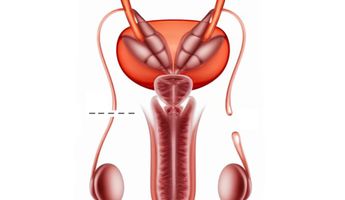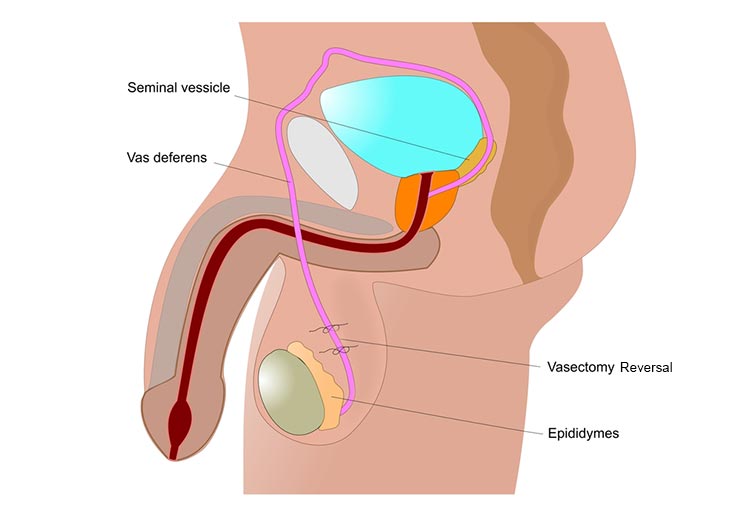Reverse Vasectomy in Saudi Arabia
Search and Compare the Best Clinics and Doctors at the Lowest Prices for Reverse Vasectomy in Saudi Arabia

Find the best clinics for Reverse Vasectomy in Saudi Arabia
No clinics available
Czech Republic offers the best prices Worldwide
Price: $ 322

- Home
- Saudi Arabia
WHY US?
At Medijump, we're making medical easy. You can search, compare, discuss, and book your medical all in one place. We open the door to the best medical providers worldwide, saving you time and energy along the way, and it's all for FREE, no hidden fees, and no price markups guaranteed. So what are you waiting for?

Free

Best Price

Widest Selection

Risk-Free
What you need to know about Reverse Vasectomy in Saudi Arabia

Vasectomy is a procedure in which a male’s vas deferens tube is sealed, cut or tied to prevent the passage of sperms to the urethra. This is a permanent contraceptive technique to avoid fertilization of egg through sexual intercourse. The reversal of this method is known as reverse vasectomy. In this procedure, the ligated vas deferens tube is re-connected. It is an expensive and complicated procedure with not a great success rate. After going through this, the fertility of a male is restored and he is able to get his partner pregnant. Reverse vasectomy can be performed at any time even after a gap of 10-15 years as the sperms are continuously been produced and are viable. The pregnancy rates after this can be as low as 30% to as high as 90% depending upon the procedure used. Only 6% of all the men gone through vasectomy go for a reversal technique.
What does a Reverse Vasectomy Procedure Involve?
The surgery is performed under local, general, or regional anesthesia under the supervision of an expert urologist. A cut is given on the scrotum which opens it making the ductus deferens visible. The duct is released from the surrounding tissues and the doctor proceeds with the surgery. There are two known methods for the reversal of vasectomy:
- Vasovasostomy: In this method cut edges of the vas deferens are connected together through stitches. The surgeon sews the ends of this tube together. This reconnects the ductus deferens and the path of semen from testes to the penis is restored. This method has a lower success rate than vasoepididymostomy.
- Vasoepididymostomy: This procedure is far more complex than the one mentioned above and is performed only when the success rate seems very low with vasovasostomy. In vasoepididymostomy, severed vas deferens is connected to epididymis rather than the other end of the tube. This results in a direct transfer of sperms into the semen present in the duct. The success rate is higher in this method. Sometimes both these procedures are performed side by side. Vasovasostomy at one side and vasoepididymostomy at the other.
Only the urologist can decide which procedure should be chosen for you. However, a vasovasostomy is performed if the sperms are present in the vasal fluid. If not, vasoepididymostomy is performed. It causes the sperms to move from testes to epididymis and from epididymis to the vasal fluid.
How Long Should I Stay in Saudi Arabia for a Reverse Vasectomy Procedure?
Performed in the outpatient department, reverse vasectomy is not a lengthy procedure. The surgery requires only 2 to 4 hours after which the patient is discharged on the same day from the hospital after he returns to consciousness. Still, the patient is under the influence of anesthesia so he needs someone to be with him. As far as stitches are concerned, they dissolve themselves after a few days. You should plan to stay in Saudi Arabia for at least 2 to 3 days after your surgery, this will allow for the initial recovery and follow-up check-ups, etc.
What's the Recovery Time for Reverse Vasectomy Procedures in Saudi Arabia?
The recovery time after a reversal vasectomy varies from person to person. It usually takes 5 days to 2 weeks for the recovery. In the first few hours, the patient is woozy due to anesthesia. There is nausea, muscle pain, swelling, fatigue, and sore throat. After the effects of anesthesia fade away the day after surgery, pain is elevated. The recovery process is completed in 2 weeks.
What sort of Aftercare is Required for Reverse Vasectomy Procedures in Saudi Arabia?
The incision is stitched and covered with bandages. There is pain after surgery which varies from moderate to severe. Pain killers are prescribed to relieve the aching body. For soreness and swelling, ice packs are used. Keeping your legs above the head level might also be beneficial in reducing swelling. Ice packs are applied every half an hour for 10 minutes. Bed rest should be taken to avoid excessive movement of testes during activity. Ask the doctor when to remove the bandages. Besides all the things mentioned above, the following points should be kept in mind:
- Keep the site of surgery dry. Avoid taking a bath or swimming for at least 1-2 days after surgery.
- Avoid all such activities which cause excessive testicle movements such as jogging, running, etc. for 6 to 8 weeks after being operated upon.
- Use sports underwear for several weeks which is tight enough to keep the testes in place.
- Do not have sexual intercourse soon after undergoing surgery. Ask your surgeon when it is fine to have intercourse and to ejaculate. You should not be ejaculating for 2 to 3 weeks after surgery.
- It is advised to take rest if your job is hectic and requires physical work. However, if you do office work, you can return to it a few days after surgery.
What's the Success Rate of Reverse Vasectomy Procedures in Saudi Arabia?
The success rate is variable and depends upon the individual case. Sperms come into the semen after 4 to 6 months of surgery. Your doctor regularly checks your sperm count till it returns to normal. In vasovasostomy, 6 to 12 months are required to restore the normal sperm count in the semen. While in the case of vasoepididymostomy, it might take longer. Once the sperms come back to the semen, chances to conceive can increase with the passage of time. the success rate also depends upon a number of other factors including any other illness or disease, age of female partner and the quality and quantity of sperms present in the semen.
Are there Alternatives to Reverse Vasectomy Procedures in Saudi Arabia?
A reverse vasectomy might not always be successful. There are various reasons for its failure such as any other testicular diseases. In case it fails, another surgery can be performed. If it does not work, following is the alternative for reverse vasectomy:
In vitro fertilization (IVF) of the ovum: Sperms are removed directly from the testes or epididymis using a syringe or through surgery. Success rates are higher if the female partner is younger. This procedure is way more expensive than the reversal of vasectomy. Also, there are no chances of another pregnancy. While reversal is cheaper, aids in natural birth and chances of future pregnancies are also there.
Fertilization through a donated sperm is another option. You can either get sperm from a suitable donor from a sperm bank or you can use your own frozen sperms that were stored before vasectomy. Sperms are removed through a syringe and frozen under suitable conditions.
Whilst the information presented here has been accurately sourced and verified by a medical professional for its accuracy, it is still advised to consult with your doctor before pursuing a medical treatment at one of the listed medical providers
No Time?
Tell us what you're looking for and we'll reachout to the top clinics all at once
Enquire Now

Popular Procedures in Saudi Arabia
Prices Start From $500

Prices Start From $2,473

Prices Start From $683

Prices Start From $275

Recommended Medical Centers in Saudi Arabia for procedures similar to Reverse Vasectomy

- Interpreter services
- Translation service
- Religious facilities
- Medical records transfer
- Medical travel insurance
- Health insurance coordination
- TV in the room
- Safe in the room
- Phone in the room
- Private rooms for patients available

- Interpreter services
- Translation service
- Religious facilities
- Medical records transfer
- Medical travel insurance
- Health insurance coordination
- TV in the room
- Safe in the room
- Phone in the room
- Private rooms for patients available

- Interpreter services
- Translation service
- Religious facilities
- Medical records transfer
- Medical travel insurance
- Health insurance coordination
- TV in the room
- Safe in the room
- Phone in the room
- Private rooms for patients available
Reverse Vasectomy in and around Saudi Arabia
Introduction
The Kingdom of Saudi Arabia is the birthplace of Islam and is home to the holy Muslim city of Mecca, all Muslims are required to make a pilgrimage to this city at least once during their life and non-Muslims are forbidden from the city. There are other wonders to be found here, from the Red Sand Dunes in Riyadh, Jeddah’s coral architecture, to the azure waters of the Red Sea. In the last few years, the Kingdom has developed a plan to encourage international patients to seek treatment at its medical centers. The healthcare sector in the country has constantly improved and developed and the country has all the attributes to have a successful medical tourism industry, such as ultra-modern hospitals that are well-equipped with cutting-edge technology, foreign-trained doctors and specialists, and a well-established private healthcare sector.
Popular Cities and Regions in Saudi Arabia
The capital city is Riyadh, which is one of the wealthiest cities in the world. It offers amazing attractions for tourists, such as the Masmak Fortress, the National Museum, the Kingdom Center, the Sky Bridge, Riyadh Zoo, and the Antiquities Museum. Another popular city is Jeddah, which is called the Bride of the Red Sea. It’s a large metropolitan city with an incredible waterfront and beautiful old town. It’s the traditional gateway to Mecca, as well as the historic crossroads of traders and pilgrims. Most tourists visit this city to admire its World Heritage Red Sea architecture, explore its lively souq, relax in its laid-back coastline, and try its world-class cuisine.
Transport in Saudi Arabia
King Fahd International Airport is the largest airport in Saudi Arabia, located in the city of Dammam. It serves flights to and from numerous cities in Europe, Asia, and the Middle East. Domestic flights are the best way to travel around this country. Buses, taxis, and car rental are widely available for travel inside the cities.
Visas in Saudi Arabia
Almost all nationalities need to have a visa to visit Saudi Arabia, except for citizens of Bahrain, Kuwait, Oman, and the UAE. eVisa or visa on arrival is available for holders of passports of 51 countries, including all EU countries, the US, the UK, and Japan. Most other countries need to obtain a visa prior to arrival.
Weather in Saudi Arabia
Saudi Arabia has two seasons, summer and winter. Summer (April – October). The weather is extremely hot and humid. The average temperatures range between 40oC to 45oC, but it can soar to 49oC. Winter, from November to March, brings mild temperatures, with an average of 20oC during the day and 10oC during the night.
Additional Info
- Local Currency: Saudi riyal (SAR) is the currency. 1 USD is equivalent to 3.75 SAR.
- Money & Payments: ATMs are widespread and credit cards are widely accepted. There is no tipping culture.
- Local Language: Arabic is the official language, but English is widely spoken.
- Local Culture and Religion: Women do not need to wear abayas (a long black, robe-like dress) anymore, except at religious sites. However, both men and women have to wear modest clothing and refrain from showing too much skin. Islam is the state religion and the country’s law requires all citizens to be Muslim. Any non-Muslims who want to acquire Saudi Arabian nationality will have to convert to Islam. There are Hindus, Christians, and Buddhists in the country but all of them are foreign nationals.
- Public Holidays: The most celebrated public holidays in Saudi Arabia are Eid Al-Fitr, Eid Al-Adha, ad National Day.
Popular Searches
- Plastic Surgery in Thailand
- Dental Implants in Thailand
- Hair Transplant in Thailand
- Breast Augmentation Thailand
- Gastric Sleeve in Thailand
- Gender Reassignment Surgery in Thailand
- Laser Hair Removal in Bangkok
- Botox in Bangkok
- Dermatology in Bangkok
- Breast Augmentation in Bangkok
- Coolsculpting in Bangkok
- Veneers in Turkey
- Hair Transplant in Turkey
- Rhinoplasty in Turkey
- Stem Cell Therapy in Mexico
- Rhinoplasty in Mexico
- Liposuction in Mexico
- Coolsculpting in Tijuana
- Rhinoplasty in Korea
- Scar Removal in Korea
- Gastric Sleeve in Turkey
- Bone Marrow Transplant in India
- Invisalign in Malaysia
- Plastic Surgery in the Dominican Republic
- Tummy Tuck in the Dominican Republic
- Plastic and Cosmetic Surgery in Poland
- Rhinoplasty in Poland
- Hair Implant in Poland
- Dental Implants in Poland
- IVF in Turkey